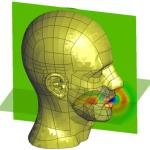Second year of the EUNISON project of numerical simulation of the human voice

Last Thursday April 16th the World Voice Day was celebrated. A team of La Salle-URL participated in the European project EUNISON, already in its second year. Voice is the main channel of communication between people. Babies generate sounds in their first months of life and children learn to speak in a few years. Being able to accurately simulate the functioning of the voice organ, from muscle activation to the final sound generated, can allow in the future to predict the effects of possible pathologies of the vocal cords, have new tools to facilitate the work of speech therapists or reproduce the voice of a particular individual. EUNISON (Extensive Unified-domain simulation of the human Voice,works in this research www.eunison.eu).This project, with participation of Spanish (La Salle-URL and CIMNE), Swedish (KTH), French (Gipsa-Lab) and German (FAU) scientists, intended to numerically simulate human speech production. The physical mechanisms that allow us to generate voice naturally are extremely complex. Air flowing from the lungs produces the vibration of the vocal cords, generating an acoustic pole that is modulated as it passes through the vocal tract and, finally, results in an emitted sound. This process involves turbulent air flows and acoustic waves propagating in a moving tube geometrically convoluted (the vocal tract). Parts of this tube collide among them, just as do the vocal cords when vibrate, according to the pronounced sound. The physic equations that allow us to describe all these phenomena are not simple and can only be solved using numerical methods. Throughout the second half of the twentieth century, numerical methods have been used mainly to solve problems associated with engineering: from the calculation of the structure of a building to the design of an aircraft wing profile, the issues addressed are countless. The relatively recent construction of supercomputing centres has enabled simulations that were unthinkable until now. A notable example is the functioning of various aspects of the human body, from the heartbeat to the biomechanics of a muscle, or the human speech production, the central objective of EUNISON project. As an example, a simple fricative such as / s / requests several hours of calculation in a supercomputing centre, and generation of syllables may incur days. The second annual follow-up meeting of the EUNISON project recently took place in Grenoble. This is a research project framed in the projects of the European Union on Future and Emerging Technologies (FET), corresponding to the seventh Framework Programme for Research and Technological Development. Throughout the first year of EUNISON, efforts focused on the simulation of the vocal cords vibration and vocal tract acoustic in order to generate vowels. In both cases the results of the numerical simulations were compared with measurements done by mechanical replica made in 3D printers. In this second year of the project the diphthongs production as / ai / has been tackled. This involves work on dynamic vocal tracts, generating more complex sounds like fricative / s /, and biomechanics of the different muscle groups involved in generating a particular sound has been modeled. The third and final year of EUNISON be the year of the great unification. The goal is to make a joint numerical simulation that encompasses from muscle activation to the sound finally emited, incorporating the vibration of the vocal cords and the movement of the vocal tract. A simulation of this type, which require a high computational cost, allow generating syllables such as / sa /.